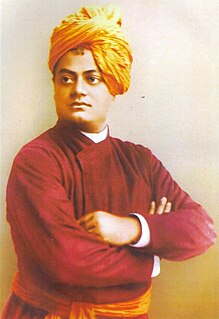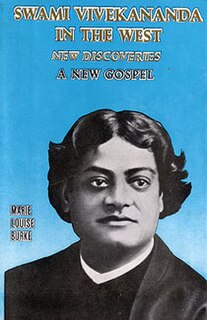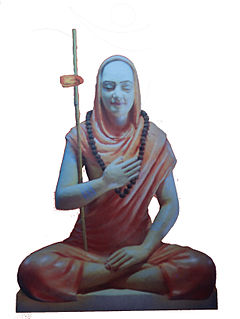
Swami Vivekananda, born Narendranath Datta, was an Indian Hindu monk, philosopher, author, religious teacher, and the chief disciple of the Indian mystic Ramakrishna. He was a key figure in the introduction of Vedanta and Yoga to the Western world; and is credited with raising interfaith awareness, and bringing Hinduism to the status of a major world religion. Vivekananda became a popular figure after the 1893 Parliament of Religions in Chicago, where he began his famous speech with the words, "Sisters and brothers of America...," before introducing Hinduism to Americans. He was so impactful at the Parliament that an American newspaper described him as, “an orator by divine right and undoubtedly the greatest figure at the Parliament”. After great success at the Parliament, in the subsequent years, Vivekananda delivered hundreds of lectures across the United States, England and Europe, disseminating the core tenets of Hindu philosophy, and founded the Vedanta Society of New York and the Vedanta Society of San Francisco, both of which became the foundations for Vedanta Societies in Western world.

The Upanishads are late Vedic Sanskrit texts that supplied the basis of later Hindu philosophy. They are the most recent part of the Vedas, the oldest scriptures of Hinduism, and deal with meditation, philosophy, consciousness, and ontological knowledge; earlier parts of the Vedas deal with mantras, benedictions, rituals, ceremonies, and sacrifices. While among the most important literature in the history of Indian religions and culture, the Upanishads document a wide variety of "rites, incarnations, and esoteric knowledge" departing from Vedic ritualism and interpreted in various ways in the later commentarial traditions. Of all Vedic literature, the Upanishads alone are widely known, and their diverse ideas, interpreted in various ways, informed the later traditions of Hinduism.
Vedanta, also Uttara Mīmāṃsā, is one of the six (āstika) schools of Hindu philosophy. Literally meaning "end of the Vedas", Vedanta reflects ideas that emerged from, or were aligned with, the speculations and philosophies contained in the Upanishads, specifically, knowledge and liberation. Vedanta contains many sub-traditions, all of which are based on a common group of texts called the "Three Sources" (prasthānatrayī): the Upanishads, the Brahma Sutras and the Bhagavad Gita.

Advaita Vedanta is a Hindu sādhanā, a path of spiritual discipline and experience, and the oldest extant tradition of the orthodox Hindu school Vedānta. The term Advaita refers to the idea that Brahman alone is ultimately real, while the transient phenomenal world is an illusory appearance (maya) of Brahman. In this view, (jiv)Ātman, the experiencing self, and Ātman-Brahman, the highest Self and Absolute Reality, is non-different. The jivatman or individual self is a mere reflection or limitation of singular Ātman in a multitude of apparent individual bodies.

In spirituality, nondualism, also called nonduality and nondual awareness, is a fuzzy concept originating in Eastern philosophy and religion for which many definitions can be found, including: advaita, nondual awareness, the nonduality of seer and seen or nondifference of subject and object; advaya, the identity of phenomena and the Absolute, or the "nonduality of duality and nonduality"; and monism, the nonplurality of the world and "the interconnection of all things." It may also refer to a negation of dualistic thinking; and to the mystical unity of God and man.
Badarayana was an Indian philosopher and sage who was the reputed author of Brahma Sutras, the source text for the Hindu philosophical school of Vedānta. Estimates of his lifetime vary very widely from around fifth century BCE to third or fourth century CE.
Satcitananda is an epithet and description for the subjective experience of the ultimate unchanging reality, called Brahman, in certain branches of Hindu philosophy, especially Vedanta. It represents "existence, consciousness, and bliss" or "truth, consciousness, bliss".

The Māṇḍūkya Upaniṣad is the shortest of all the Upanishads, and is assigned to Atharvaveda. It is listed as number 6 in the Muktikā canon of 108 Upanishads.
Swami Tyagananda is a Hindu monk of the Ramakrishna Order and presently the head of the Vedanta Society in Boston. Currently, he is also the Hindu chaplain at MIT and Harvard. He has presented papers at academic conferences, and he gives lectures and classes at the Vedanta Society, MIT, Harvard, and other colleges in and around Boston.

Sister Gargi, born Marie Louise Burke, was a writer and an eminent researcher on Swami Vivekananda, and a leading literary figure of the Ramakrishna-Vivekananda movement. Gargi was introduced to the Ramakrishna-Vivekananda movement in 1948 by Swami Ashokananda. She is known for her six-volume work, Swami Vivekananda in the West: New Discoveries. Her New Discoveries are considered as indispensable for Swami Vivekananda research.

The Bhagavad Gita, often referred to as the Gita, is a 700-verse Hindu scripture that is part of the epic Mahabharata, dated to the second half of the first millennium BCE and is typical of the Hindu synthesis. It is considered to be one of the holy scriptures for Hinduism.

Swami Vivekananda was a Hindu monk from India. His teachings and philosophy are a reinterpretation and synthesis of various strands of Hindu thought, most notably classical yoga and (Advanta) Vedanta, with western esotericism and Universalism. He blended religion with nationalism, and applied this reinterpretation to various aspect's of education, faith, character building as well as social issues pertaining to India. His influence extended also to the west, and he was instrumental in introducing Yoga to the west.

Swami Vivekananda in the West: New Discoveries is a series of biographical books on Swami Vivekananda written by Marie Louise Burke, who is popularly known as Sister Gargi. There are six volumes in the series. This series of books was first published in two volumes in 1957. In 1983–87, these series was republished in six volumes. The book is high acclaimed not just in India but also in the Vedanta circles around the world.

Josephine MacLeod was an American friend and devotee of Swami Vivekananda. She had a strong attachment to India and was an active participant in the Ramakrishna Vivekananda movement. She was given the nicknames "Tantine" and "Jo Jo" by Vivekananda. She considered Swami Vivekananda to be her friend and helped him with his finances. MacLeod was not a sanyasin, unlike many others such as Sister Nivedita or Sister Christine. She was instrumental in spreading Vivekananda's message on Vedanta in the West. She made many contributions to the initial and the later phases of the development of the order of Ramakrishna and Vivekananda. She was a contributor to many causes espoused by Sister Nivedita, the most famous disciple of Vivekananda, including that of contributing financially towards the development of the Indian National Movement especially in Bengal and elsewhere in India.

Swami Vivekananda (1863–1902) was an Indian Hindu monk and a key figure in the introduction of Indian philosophies of Vedanta and Yoga to the western world. He was one of the most influential philosophers and social reformers in his contemporary India and the most successful and influential missionaries of Vedanta to the Western world. Indian Nobel laureate poet Rabindranath Tagore's suggested to study the works of Vivekananda to understand India. He also told, in Vivekananda there was nothing negative, but everything positive.

Neo-Vedanta, also called Hindu modernism, neo-Hinduism, Global Hinduism and Hindu Universalism, are terms to characterize interpretations of Hinduism that developed in the 19th century. The term "Neo-Vedanta" was coined by German Indologist Paul Hacker, in a pejorative way, to distinguish modern developments from "traditional" Advaita Vedanta.

Swami Vivekananda, the 19th-century Indian monk, came to Los Angeles, California in 1899 during his second visit to the West. His oratorical skills and presentation of Hindu religious tenets and comparison with other religious beliefs made him a celebrity among a wide spectrum of American audience. Between 1893—1897 and 1899–1902, he traveled widely in the US lecturing on a wide range of subjects and also established Vedanta Centers. There are such centers in many cities in the US, including many centers in California. In 1899, after delivering lectures in New York, he travelled to the western part of the United States and reached Los Angeles via Chicago. He then went on to deliver lectures in California at Oakland, San Francisco and Alameda.

Vedanta Society of New York (VSNY) was the first Vedanta Society founded by the Indian Hindu monk Swami Vivekananda in New York in November 1894. In 1897, Swami Abhedananda, another disciple of Ramakrishna, came to the United States and took charge of the society. He was the president of the society until 1921. The Vedanta Society is affiliated with the Ramakrishna Math religious monastic order and the Ramakrishna Mission.
Meditation played a very important role in the life and teachings of Swami Vivekananda. He was interested in meditation from his childhood. His master Ramakrishna found him a dhyana - siddha . On 24 December 1892, Vivekananda reached Kanyakumari and meditated for three days on a large rock and took the resolution to dedicate his life to serve humanity. The event is known as the Kanyakumari resolve of 1892. He reportedly also meditated for a long time on the day of his death.

Advaita Vedānta is the oldest extant tradition of Vedānta, and one of the six orthodox (āstika) Hindu philosophies. Its history may be traced back to the start of the Common Era, but takes clear shape in the 6th-7th century CE, with the seminal works of Gaudapada, Maṇḍana Miśra, and Shankara, who is considered by tradition and Orientalist Indologists to be the most prominent exponent of the Advaita Vedānta, though the historical fame and cultural influence of Shankara grew only centuries later, particularly during the era of the Muslim invasions and consequent reign of the Indian subcontinent. The living Advaita Vedānta tradition in medieval times was influenced by, and incorporated elements from, the yogic tradition and texts like the Yoga Vasistha and the Bhagavata Purana. In the 19th century, due to the interplay between western views and Indian nationalism, Advaita came to be regarded as the paradigmatic example of Hindu spirituality, despite the numerical dominance of theistic Bkakti-oriented religiosity. In modern times, its views appear in various Neo-Vedānta movements.














